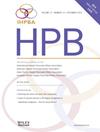Combined division of the splenic vessels and pancreatic parenchyma during laparoscopic distal pancreatectomy is a safe alternative to separate division: a single-institution retrospective study
IF 2.7
3区 医学
Q2 GASTROENTEROLOGY & HEPATOLOGY
引用次数: 0
Abstract
Background
Limited data exists regarding the safety and outcomes of combined division of the splenic vessels with the pancreatic parenchyma during laparoscopic distal pancreatectomy (LDP). This study aims to evaluate the combined division technique.
Methods
Patients who underwent LDP for pancreatic cancer from April 2011 to December 2022 were retrospectively reviewed and categorized into the following groups: combined (CV) versus separate (SV) division of the splenic vein; combined (CA) versus separate (SA) division of the splenic artery; and combined (CAV) versus separate (SAV) division of the splenic artery and vein, with or without the pancreatic parenchyma.
Results
Among the 80 patients included, 44 underwent CV and 36 underwent SV. Operative time and major morbidity were significantly lower in CV compared with SV. Similar findings were observed in CAV versus SAV, as well as lower blood loss in CAV. Operative time was significantly lower in CA versus SA. Pancreatic fistula and postpancreatectomy hemorrhage rates showed no significant differences between groups. No patient developed splenic arteriovenous fistula in follow-up.
Conclusion
Combined division of the splenic vessels with the pancreatic parenchyma during LDP is safe and associated with improved outcomes compared with separate division.
腹腔镜胰腺远端切除术中合并分割脾血管和胰腺实质是一种安全的替代单独分割的方法:一项单一机构的回顾性研究。
背景:有关腹腔镜胰腺远端切除术(LDP)中脾血管与胰腺实质联合分割的安全性和结果的数据有限。本研究旨在评估联合分割技术:回顾性研究2011年4月至2022年12月期间因胰腺癌接受腹腔镜胰腺切除术的患者,并将其分为以下几组:脾静脉联合(CV)与单独(SV)分割;脾动脉联合(CA)与单独(SA)分割;脾动脉与静脉联合(CAV)与单独(SAV)分割,有无胰腺实质:在纳入的 80 位患者中,44 位接受了 CV,36 位接受了 SV。与 SV 相比,CV 的手术时间和主要发病率明显较低。CAV与SAV的结果相似,CAV的失血量更低。CA与SA相比,手术时间明显更短。胰瘘和胰腺切除术后出血率在组间无明显差异。随访中没有患者出现脾动静脉瘘:结论:在 LDP 期间将脾血管与胰腺实质合并分割是安全的,与单独分割相比,其结果更好。
本文章由计算机程序翻译,如有差异,请以英文原文为准。
求助全文
约1分钟内获得全文
求助全文
来源期刊

Hpb
GASTROENTEROLOGY & HEPATOLOGY-SURGERY
CiteScore
5.60
自引率
3.40%
发文量
244
审稿时长
57 days
期刊介绍:
HPB is an international forum for clinical, scientific and educational communication.
Twelve issues a year bring the reader leading articles, expert reviews, original articles, images, editorials, and reader correspondence encompassing all aspects of benign and malignant hepatobiliary disease and its management. HPB features relevant aspects of clinical and translational research and practice.
Specific areas of interest include HPB diseases encountered globally by clinical practitioners in this specialist field of gastrointestinal surgery. The journal addresses the challenges faced in the management of cancer involving the liver, biliary system and pancreas. While surgical oncology represents a large part of HPB practice, submission of manuscripts relating to liver and pancreas transplantation, the treatment of benign conditions such as acute and chronic pancreatitis, and those relating to hepatobiliary infection and inflammation are also welcomed. There will be a focus on developing a multidisciplinary approach to diagnosis and treatment with endoscopic and laparoscopic approaches, radiological interventions and surgical techniques being strongly represented. HPB welcomes submission of manuscripts in all these areas and in scientific focused research that has clear clinical relevance to HPB surgical practice.
HPB aims to help its readers - surgeons, physicians, radiologists and basic scientists - to develop their knowledge and practice. HPB will be of interest to specialists involved in the management of hepatobiliary and pancreatic disease however will also inform those working in related fields.
Abstracted and Indexed in:
MEDLINE®
EMBASE
PubMed
Science Citation Index Expanded
Academic Search (EBSCO)
HPB is owned by the International Hepato-Pancreato-Biliary Association (IHPBA) and is also the official Journal of the American Hepato-Pancreato-Biliary Association (AHPBA), the Asian-Pacific Hepato Pancreatic Biliary Association (A-PHPBA) and the European-African Hepato-Pancreatic Biliary Association (E-AHPBA).
 求助内容:
求助内容: 应助结果提醒方式:
应助结果提醒方式:


